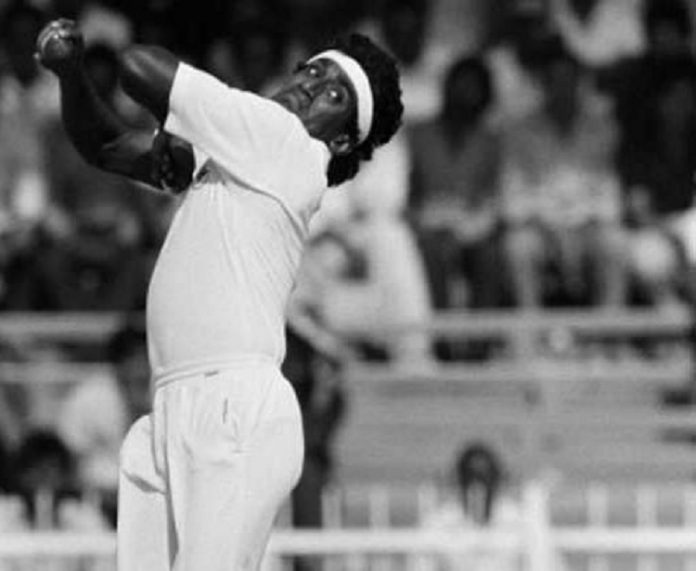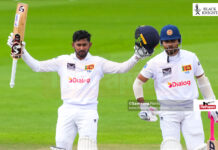The Christchurch Test match 35 years ago saw seven Sri Lankans making their debuts. Something that was forced on the Sri Lankans, after some of their top players going on the rebel tour. To add insult to injury, both new captain Duleep Mendis and deputy Roy Dias were out of series due to injuries and leg-spinner D.S. de Silva stepped in to lead the side.
Although Christchurch’s international cricket at present has shifted to Hagley Oval, those days games were played at Lancaster Park. The venue that hosted New Zealand’s first ever Test match in 1929 has ceased to host international matches after the 2011 earthquake.
In Christchurch, the new ball was shared by two debutants –Vinothan John and Rumesh Ratnayake, both Peterites. Rumesh was still at school and in fact as a schoolboy he toured India and Australia as well.
Read More : Cricket needs Chandrishan back badly
While a school boy was holding the new ball for Sri Lanka, in the opposition camp the new ball was entrusted to one Sir Richard Hadlee, whom Rumesh says taught him the finer points of fast bowling.
Although John claimed a five wicket haul in the first innings of the second Test at Wellington, it was the hostile pace of Rumesh that took the attention and made the headlines all over New Zealand.
John Wright, the accomplished Kiwi top order batsman was struck by a vicious bouncer. It left Wright with a broken nose. Wright was down but not out and resumed his innings. But Rumesh, the man who hit the batsman was shaken up and fainted.
An image of the incident or a video clip cannot be found anywhere, but there is proof for Rumesh’s deadly pace in another YouTube clip. At a time when Clive Lloyd’s all pace attack was terrorizing the world, the Sri Lankan duo of Ashantha De Mel and Rumesh were having a field day at the MCG during a Benson and Hedges World Series game in 1985.
De Mel hit Richie Richardson and forced him to retire with broken teeth. A few balls later it was Rumesh’s turn to send Larry Gomes back to the pavilion with a broken cheek bone. Notice how Rumesh rushed to inquire on the wellbeing of the batsman and upon seeing blood, withdrawing himself from ‘the crime scene’.
Read More : Reminiscing Sri Lanka’s first overseas win in New Zealand
And listen to the legendary words of Ian Chappell on commentary. ‘Rumesh is little distressed and moved away very quickly. It has damaged the cheek bone.’’
Richie Benaud follows. ‘Very nasty blow indeed.’
In this day and age when fast bowlers and their captains intimidate opposition batsmen with physical harm like Michael Clarke threatening James Anderson to “get ready for ‘broken f***ing arm”, the likes of Rumesh are a rare breed.
He was genuinely concerned for someone who was hurt because of his actions. And to watch a Sri Lankan bowler hit a West Indian those days was priceless.
The fate of most Sri Lankan cricketers in the 1980s affected Rumesh too. Bilateral series in the early days for Sri Lankan cricketer were few. At times players would just play one Test match for the whole year. There were no FTPs that ensured regular home and away fixtures that current players enjoy.
Read More : Will Ashantha De Mel fix Sri Lanka’s fielding woes?
That prompted many prominent players to quit international cricket early and concentrate on other professions just to keep the home fire burning.
You always wonder what impact players of yesteryear would have had had they been given regular opportunities. You also wonder whether Sri Lanka’s fast bowling strength in the 1980s was better than what it is today.
The likes of De Mel, the Ratnayakes – Rumesh and Ravi, John, Graeme Labrooy, Saliya Ahangama and many others suffered due to lack of opportunities and all of them retired prematurely. The batsmen suffered the same fate with the likes of Sidath Wettimuny and Ranjan Madugalle retiring early to focus on their professional careers.
After retiring some of these players got involved in the game in one capacity or the other. Rumesh joined Sri Lanka Cricket in late 1990s and was in-charge of the newly created Pace Academy. He then joined Asian Cricket Council before rerunning to SLC as the Assistant Coach. He had a brief stint as Head Coach when Australia toured Sri Lanka in 2011. His latest stint started early this year under Chandika Hathurusingha.

















